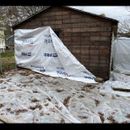Detached garage in MA
Hi.
I would like to insulate my detached wooden garage in MA, but I want to avoid condensation and mold. I accidentally stripped siding on two sides rather than strip the lead paint off (before I knew about Cobra IR paint stripper). Can I add exterior rigid insulation on just those two sides since I tore off siding there? Should I cover the other side fanfold insulation and vinyl siding to make it slightly warmer? I would use an electric heater for occasional heat. My option is to add a ridge vent and two gable vents and to create a small attic with drywall ceiling. Or should I avoid doing that? It has no soffit vents and wood block above wall seemingly blocking me from adding them. If I add a gable vent in the front, I will disrupt the water shedding layering of the original cedar shingles. I’ve been told to put mineral wool in the walls maybe covered with a membrane of some sort and ceiling or to put paper faced batt insulation and cover with drywall. I want it to be warmer so I can watch TV there. The concrete slab is from 1940. A cathedral ceiling would increase my storage space, but I have no soffit vents and am planning to add a ridge vent.
should I just add fanfold insulation on all three sides and cover with vinyl siding? Will it make it slightly warmer without creating condensation? What if I add a ridge vent – will it make it extra cold?
Or should I abandon the idea and let it air out and be here for another hundred years?
Thank you
GBA Detail Library
A collection of one thousand construction details organized by climate and house part











Replies
Alright, diving straight into the heart of your garage insulation conundrum in MA, let's cut through the fluff and get down to brass tacks. You’ve got yourself a bit of a classic situation with a twist – insulating a detached wooden garage while dodging condensation and mold like it's a bad cold.
Exterior Rigid Insulation on Stripped Sides:
Absolutely, slap that exterior rigid insulation on the sides where you’ve already torn off the siding. It’s like giving your garage a new winter coat where it’s needed most. Think of it as patching a pair of jeans – you don’t need new pants, just shore up where it’s drafty. For the best moisture management, ensure that the insulation is properly detailed with a weather-resistant barrier that overlaps correctly at the seams.
Fanfold Insulation on Other Sides:
Adding fanfold insulation under new vinyl siding on the rest of the garage is a light touch, but it’s something. It's like wearing a windbreaker instead of a coat – not as warm, but it cuts the chill. Just make sure the vinyl siding is installed in a way that doesn’t trap moisture.
Ventilation vs. Cathedral Ceiling:
Your garage, like any good building, needs to breathe without catching a draft. Your idea of a ridge vent paired with gable vents without proper intake is like trying to breathe with your mouth covered – it’s not going to work well. You need balance. Without soffit vents, consider alternative intake vents that don’t mess with your existing setup too much.
Creating a small attic space with a drywall ceiling is a neat idea to compartmentalize your ventilation, but remember, ventilation in a space like this is about moving air from where you don’t want it to where it won’t do harm. As for the cathedral ceiling – enticing for the extra space, but tricky without proper venting. You’re inviting moisture problems if you can’t get air to flow right.
Insulation Material:
Mineral wool in the walls? Solid choice. It’s like wool socks – warm, moisture-tolerant, and doesn’t itch (unless you’re a fiberglass batt, maybe). Cover it with a smart vapor retarder to let the walls dry out. For the ceiling, if you’re dead set against foam, dense pack cellulose is like a down comforter – snug and effective. Just make sure it’s contained properly so it doesn’t settle and leave you with cold spots.
Final Thought:
Don’t throw in the towel. With some strategic insulation, proper moisture control, and a bit of ingenuity with your ventilation, you can turn this garage from a cold storage unit into a cozy retreat. Keep the exterior rigid where you’ve already made changes, consider light insulation like fanfold where you haven’t, and get creative but cautious with your ventilation to avoid disrupting the original cedar shingles too much. Remember, it's all about balance – moisture control, insulation, and air movement. Get those in harmony, and you'll have a space that's comfortable year-round, no matter what you're doing in there.